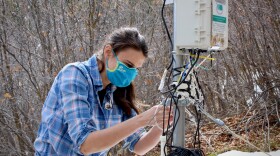Last year saw vicious wildfires tear through Colorado. That included the three largest blazes in the state’s history and the Grizzly Creek Fire, which burned more than 30,000 acres near Glenwood Springs. This year, with much of the area in drought and summer right around the corner, experts say conditions in the Roaring Fork Valley are again ripe for wildfires.
“Things can turn on a dime around here, and I’m hoping it does with some moisture coming in,” said Jim Genung, a fire manager and fuels specialist based in Rifle. “But I gotta say, it’s starting to look a little bit like we’re going to head into a busy summer again.”
Genung’s jurisdiction with the Upper Colorado Interagency Fire Management Unit includes both Bureau of Land Management and White River National Forest land.
Because indicators are pointing to another busy season, he says, the people who monitor wildfires are in a “heightened state of awareness” looking at this year’s conditions.
“Everyone is a little on edge while we wait and see what’s going to happen this summer,” said Leanne Veldhuis, Eagle-Holy Cross district ranger in the White River National Forest.
As agencies like the Forest Service look ahead, last summer’s extraordinary burns are casting a shadow over this year’s preparation.
“I think there’s a lot of exhaustion from last season that everyone is still feeling,” Veldhuis said. “So ramping up for what everyone is expecting to be another big season nationally – at the top of the list is making sure that people are being resilient and safe and ready to go again.”
How to forecast a fire season
The fire predictions referenced by Veldhuis and others are based on a variety of factors. Precipitation in the months leading up to fire season plays a role. This past winter, there was not much of it.
“We just didn't get the big storms that we would typically get,” Genung said. “There were one or two cycles there that were okay, but usually we get three to five really good snow cycles.”
Those storms are the kind that make for “epic” skiing, he said, stringing together three to five days of fresh powder. They were especially absent in the early and late phases of this past winter.
The warmer end of the valley skewed dry too, with rain and snow totals falling below normal. Rifle only saw three inches of precipitation all year – less than a quarter of the annual average. The gauge at Rifle Garfield County Airport typically measures 13 inches per year.
Long-range forecasts show they may tick back up in the middle of summer after a couple more months of unusually dry weather.
But because of the low precipitation so far, everything on the ground has a higher risk for burning. Plants on the ground, dead and alive, are considered “fuel.” Figuring out how dry they are can play a major role in predicting the likelihood of wildfire.
Dead plants – from twigs the size of your finger to fallen trees – are more flammable when they are holding less moisture.
“We are seeing low numbers right now at the lower elevations,” he said. “And some of those numbers are a little bit – I don't want to say startling – but low.”
Living plants are another factor he looks at – everything from sagebrush to towering evergreens. When they are lush and verdant, they are full of moisture and less likely to burn. But in recent years, Genung has noticed that vegetation is less saturated at its peak, and then dry all the way out before they’re supposed to. That shows up in the timing of fall colors.
“Typically, you see leaves change colors in September, October,” he said. “We were seeing leaves change colors in August in some of the brush types. It drops off back to near dormancy two months early.”
On top of all those natural factors are human risks. Genung says increased visitation to the area and its outdoor spaces is driving up the chances of a human-caused wildfire, meaning residents and visitors alike should be more vigilant.
“If we’re in a place where we’re saying it’s too dry, no fires, I hope people would respect that,” Genung said. “There’s things like a dragging chain on your trailer that could start a large wildfire. Be cognizant of what’s going on around you on these dry, windy days.”
Responding and preparing
Governments and firefighters are preparing their response in the event of the next catastrophic burn – which is getting more and more likely with a changing climate.
“We have no reason to believe in the Roaring Fork Valley that we are not next,” said Valerie MacDonald, Pitkin County emergency manager. “I don't think our luck will continue to hold. We definitely have to plan for the worst.”
Part of that planning has involved pulling together firefighting agencies from across the valley to identify and extinguish fires early, and then work together when they get bigger.
“It's all about the initial attack and putting them out while they're small,” MacDonald said.
It’s her job to make sure that when that next big fire comes, the impact to people and structures is as small as it can be. She says residents need to take steps beforehand.
“We need them to be aware of the risk and to actually mitigate their risk, gain that by clearing defensible space, hardening their home, using fire resistant materials when possible, and a real hot button for me is evacuation planning” MacDonald said.
Because a big fire in the Roaring Fork Valley is inevitable, she says more people need a concrete plan for how to leave their home, where they are going to go, and how to make sure they can do so quickly.
MacDonald encouraged residents to visit federal and county emergency preparedness websites for more information about how to do so.







